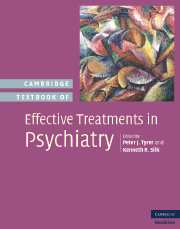Book contents
- Frontmatter
- Contents
- List of contributors
- Preface
- Part I Introduction
- Part II Summary of treatment modalities in psychiatric disorders
- 3 A critical assessment of methods and processes used to develop psychiatric drug treatments
- 4 Section I – The efficacy and safety of electroconvulsive therapy
- 4 Section II – Focal brain stimulation approaches to psychiatric treatment
- 5 The effectiveness of psychological treatments in psychiatry
- 6 Educational interventions
- 7 Complementary and alternative medicine
- 8 Complex interventions
- Part III Specific treatments
- Appendix I Summary of specific drugs having evidence of effectiveness in mental disorders
- Appendix II Key to effectiveness tables
- Index
- References
7 - Complementary and alternative medicine
from Part II - Summary of treatment modalities in psychiatric disorders
Published online by Cambridge University Press: 12 May 2010
- Frontmatter
- Contents
- List of contributors
- Preface
- Part I Introduction
- Part II Summary of treatment modalities in psychiatric disorders
- 3 A critical assessment of methods and processes used to develop psychiatric drug treatments
- 4 Section I – The efficacy and safety of electroconvulsive therapy
- 4 Section II – Focal brain stimulation approaches to psychiatric treatment
- 5 The effectiveness of psychological treatments in psychiatry
- 6 Educational interventions
- 7 Complementary and alternative medicine
- 8 Complex interventions
- Part III Specific treatments
- Appendix I Summary of specific drugs having evidence of effectiveness in mental disorders
- Appendix II Key to effectiveness tables
- Index
- References
Summary
Editor's note
While many claims are made for the effectiveness of treatment with herbs, minerals, homeopathy and acupuncture, the data that support their effectiveness are sparse. Regulations that govern these compounds and these treatments are much more lax than those laws and regulations governing other forms of treatment, and it is this lack of regulations that often can lead to claims that are not at all substantiated. The careful review presented here suggests that perhaps St John's wort has effectiveness in mild depression and kava in anxiety, though there is always the risk of liver damage. S-adenosyl-l-methionine (SAMe) is probably not effective. Valerian may, over a long period of time, provide some effectiveness for insomnia, and omega-3 fatty acids do appear effective in depression. Homeopathy has absolutely no data to support any effectiveness other than perhaps the relationship of the homeopath to the patient. Acupuncture may be helpful in nicotine dependence and alcohol withdrawal, but again the role of the relationship between the acupuncturist and the patient may be the key ingredient for any claims made to the effectiveness of this treatment.
Introduction
Complementary and alternative medicine (CAM) encompasses a wide array of methods for treating illness and maintaining health. Perhaps the only thing consistent amongst these approaches is their lack of absolute acceptability as conventional medicine. Complementary medicine refers to practices or types of medicine used in combination with conventional medicine.
- Type
- Chapter
- Information
- Cambridge Textbook of Effective Treatments in Psychiatry , pp. 132 - 156Publisher: Cambridge University PressPrint publication year: 2008



